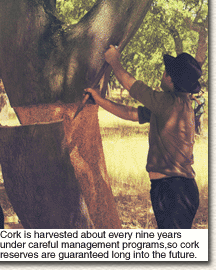Cork Floors
by
Cork is the outer bark of an evergreen oak of the genus and species Quercus Suber (oak cork). Forests of oak cork trees are carefully monitored and cultivated, and act as a renewable source for this remarkable material.

During a harvest, the outer bark of a cork oak’s trunk and major branches is carefully stripped by hand – no mechanical stripping devices are allowed. Experienced cork strippers use a specialized cork axe to slit the outer bark and peel it away from the tree.
A cork tree regenerates its precious outer layer 12 or 13 times during its 150-year lifetime. The first stripping of the cork bark occurs when the tree is between 15 and 20 years of age, with subsequent yields at 9 to 10 year intervals.
The harvested cork bark is removed from the forests, and are left out in the open air for six months. This weathering process actually improves the cork’s quality. The cork bark is then sorted by quality and size. The first use is for the extraction of cork stoppers to meet the demands of the world’s wine and champagne industries, which use over 13 billion cork stoppers annually.
The remaining cork (called “blocker waste," although it is perfectly good material!) is then ground up and processed to be used in the production of agglomerated cork and cork & rubber compounds. These materials are used in a variety of applications from construction and gaskets, to bulletin boards and decoration.
Today, the center of the world's cork oak forest is concentrated on Europe’s Iberian Peninsula and the adjacent Mediterranean basin, where soil, temperature, rainfall and wind conditions are ideal. European forests account for two-thirds of cork oak production, while North Africa produces the remaining one-third. The total land surface occupied by the cork oak forests is 2.2 million hectares (5.434 million acres), of which Portugal and Spain represent 56%.
The cork industry employs more than 15,000 workers in factories devoted to converting raw cork and cork byproducts into commercial products. In addition, the industry employs thousands of seasonal workers for the cork harvest and the maintenance of the oak forests.
In the prime cork-growing region of Portugal, cork oaks and their harvest are protected by law in order to protect this valuable resource and ensure the quality of the harvest.
